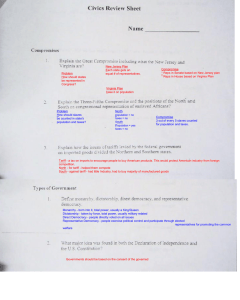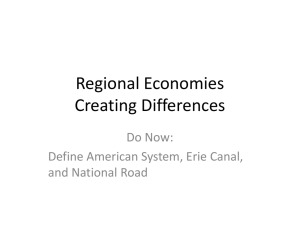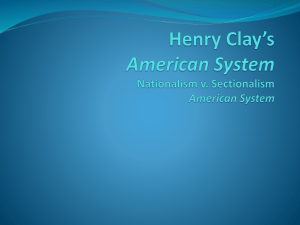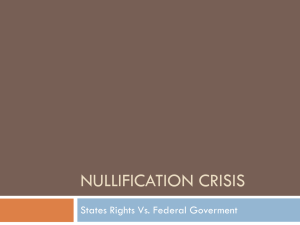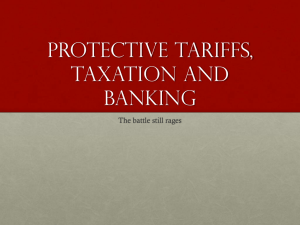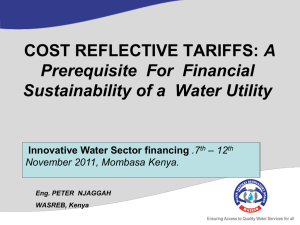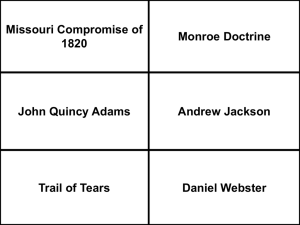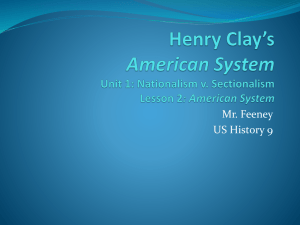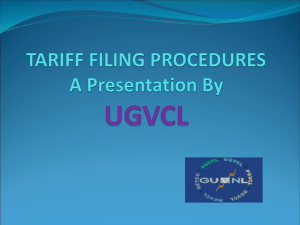Presentation 1 - Water Research Commission
advertisement
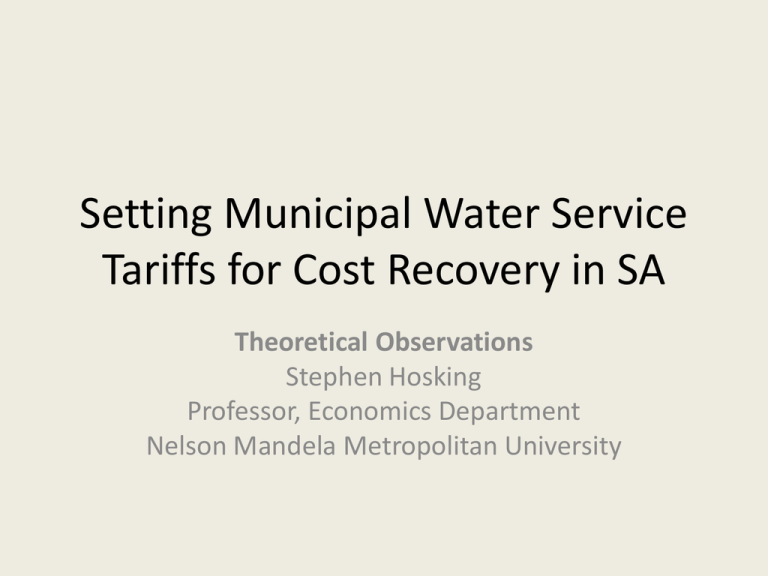
Setting Municipal Water Service Tariffs for Cost Recovery in SA Theoretical Observations Stephen Hosking Professor, Economics Department Nelson Mandela Metropolitan University Purpose of today’s seminar Interface/discussion between Theorists (and researchers), Practitioners and Policy designers and implementers – thank the WRC for facilitating + others. Presenters, we allow 15 minutes presentation and 5 minutes for discussion, plus some at the end of session. Participants, please accept my apologies up front - I will not have the time available to allow everyone to question/comment who wants to. Feedback – copies of the presentations can be obtained from Charmaine of the WRC Last but not least – indiv researcher share their thought Terms we use - please be patient when others use different terms Example of the different terms of value, often used interchangeably with respect to water service • Price – an exchange/trade value negotiated. • Charge/fee – levied by seller for the service, or another party to a trade on the trade • Tariff is a money value set, usually by a public entity or government, with the aim of recovering the cost of production, or the aim of discouraging purchase of the good/service (import tariffs). Tariff setting process may involve some negotiation, but not necessarily with buyer. Tariff setting involves, at least.. (A) The cost needing to be recovered and estimated (required revenue)* (B) Revenue collection options and principles - Revenue (QR)/ Non-revenue (QNR) divide - public education, water service package determination, tariff structure and revenue (marketing) - demand analysis – tariff elasticities - opportunity cost revenue raised (C) Assessing practice against goals - ethical goals/principles - policy self-interested voters support - ethics and political interest compared with practice/delivery – and the adequacy/instruments of monitoring and regulating Collective (social) Policy and Goals determine water service tariff setting WSA Water Input Prices Selecting WSP Pvt Firm Pub Utility Municipality (Self) Tech Choice/Cost calculation Revenue Requirement Revenue collecting method Central Govt Other Property Tax Tariffs Tariff Structure/ Demand analysis/Opport cost One Part Two Part Tariffs Economic rationale to recover cost through usage tariffs? 1. Case of potable water Potable water is a rival good, so once appropriated by a household, is unavailable for another, so can be priced like a private rival good. 2. Case of waste water Waste water is mostly generated as a by-product of the potable water service, and generates substantial external costs, if not properly managed. One way to internalise the waste water external cost into users decision making is to incorporate the waste water cost into the potable water service tariff (price). Storm water management cost is unrelated to potable water service Storm water is - partly a public good, in so far as it drains public property, like roads and pavements, and the cost for this part is best collected through property taxes - partly an externality of roofing and paving construction on privately owned land and also of illegal private storm water diversion into the waste water management system – this part can efficiently be recovered through a separate storm water tariff – is justification to feed back this revenue into the water balance accounts In which costs measures are we most interested for tariff setting? Efficiency requirement of setting the tariff level = P = SMC - for both quantity of water sold (QR) and connections added to supply network But the information available typically only allows SAC to be calculated Which is not a problem because optimal exploitation of implemented water supply schemes will bring about SMC = SAC = LAC So that Tariff = P= SMC = SAC Note that SMC is expected to decline up until the capacity of the storage and transport system is exceeded. Costing/Pricing the investment in supply infrastructure – three water supply schemes - implemented ones are (0) and (1) , planned one is (2) MC2 Average Cost in Rand per cubic metre water MC1 SACSAC 1 2 MC0 SAC1 LMC2 LAC2 LAC1 Q1 Q2 Water per cubic metre LMC LAC LAC When is the Long-run marginal cost (LMC) relevant - where scarcity cost SAC1 is not the right reference to use when there is a scarcity cost (SC), that is, increased real total cost of an increase in water supply due to increased scarcity or decreased quality of raw water available For planning purposes a planning cost structure should be used - the relevant long-run cost measures LMC2 = LAC2 + SC2 where SC2= increased real total cost between water schemes 1 and 2 = LAC2 + Q2. (LAC2 – LAC1) LAC2 = long-run average cost after scheme 2 implemented Q2 = quantity of water supplied by all three schemes: 0, 1 and 2 A water account balance approach to determining the Req Rev (RR) RR = (DCp + DCw + RC + OFC) + VC + (BD + CS) – (KG + OS) TC = Total cost = FC + VC ; FC/TC ≈ 80% DCp + DCw = depreciated cost infrastructure for potable water + depreciated cost infrastructure for waste water management RC = rehabilitation, new investment and maintenance cost OFC = Other Fixed Costs (interest on loans, wages, and so on) VC = variable cost = c(QR + QNR); where c = average variable cost multiplied by the revenue attracting quant of potable water supplied (QR) plus the non-rev quant (QNR) TRANS = transfer requirement = BD + CS = bad debts + collectively ‘agreed’ implicit tariff cross-subsidisation between users GS = government grant/subsidy = KG + OS = capital grant + operational subsidy A checklist on the components of the water account balance (DCp + DCw + RC + OFC) + VC + (BD + CS) – (KG + OS) • Is depreciation cost properly calculated for replacement? • Is rehabilitation cost adequate to maintain the assets? • Are Capital Expenditure Grants timeously applied for and spent? • Is the Government Operational Subsidy (= Equitable Share/ATTP) grant correctly applied for and allocated? • Is the transfer burden bearable? [Local Transfer Burden = (BD + CS)/TC] • Does variable cost include all components it should? Going through the VC cost checklist • VC (of QR and QNR) - chemical treatment, electricity (pumping) monitoring and testing, cost of raw water and damage through waste water disposal, etc. • Two components of VC were not included in any municipality’s water accounts that we investigated, were Opportunity cost (estimated at about 1-3% of TC) Damage costs ‘externally’ borne (estimated at about 3-7% of TC) What are the consequences of omitting from VC the opportunity and damage costs? Failure to include opportunity and external costs does not: • put at risk the sustainability of water services • nor does it cause imbalances in the financial flows underlying the water accounts , BUT may cause • greater demand for the provision of potable water services than would be efficient • less waste water management service provision being supplied than would be efficient - Siyathemba Magobiane Are there ‘new’ trends emerging in cost calculation in SA municipal tariff setting? (1) Containing VC and reducing the RC required by increasing tariff levels Q = f(Demand; Political Pressure) Demand = g(P); inverse relation P = tariff (price) (2) Introduction of increased variety/flexibility in quality of service package - with the aim of improving efficiency, e.g., cheaper lower water pressure options – Ethekwini, but we also predict others and new supply technologies introduced Jessica Hosking. Theoretical observations about costs needed to be recovered • • • • • • • • • • Advantages of market processes and private sector competition/particpation need to be considered SAC is an appropriate reference for tariff calculation The waste water charge should be internalised into the potable water charge A case for a storm water tariff can be built There may be a need for greater advice to be given to politicians on the social sacrifices required to balance the water service accounts The local transfer burden needs careful management The minimum required maintenance and rehabilitation expenditure needs to be made Investment in new infrastructure must keep pace with expectations of the population and economy Increasing use is being made of demand management to contain variable costs and avoid making new investments Adding households into a supply network where marginal connection costs are obviously higher than the expected marginal revenues raises the question of sustainability, and the spectre of idle/neglected infrastructure The END Thank you
